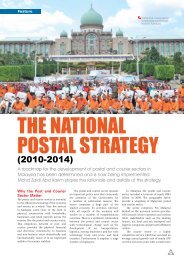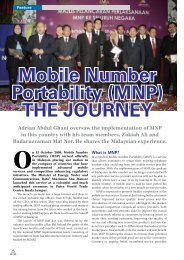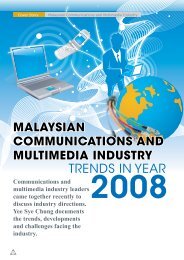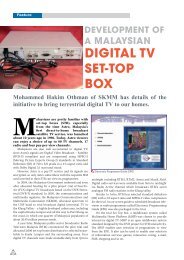The SKMM Network Security Centre - my Convergence Magazine
The SKMM Network Security Centre - my Convergence Magazine
The SKMM Network Security Centre - my Convergence Magazine
Create successful ePaper yourself
Turn your PDF publications into a flip-book with our unique Google optimized e-Paper software.
Feature<br />
Mission Statement of the NSC<br />
To reduce and mitigate the<br />
probability of cyber security<br />
risks from crystallizing by<br />
disseminating early warnings and<br />
to share information among the<br />
stakeholders thus minimizing<br />
any adverse impact to the overall<br />
network infrastructure in Malaysia<br />
<strong>The</strong> <strong>SKMM</strong> <strong>Network</strong><br />
<strong>Security</strong> <strong>Centre</strong><br />
Shamsul Jafni Shafie shares how the centre is ensuring information<br />
security and reliability of the network.<br />
We are living in<br />
a converged<br />
c o m m u n i c a -<br />
tions envir<br />
o n m e n t .<br />
<strong>Security</strong> in the converged environment<br />
is essential. Its importance<br />
cannot be stressed as what<br />
is seen from the endless surveillance<br />
and attacks from malicious<br />
hackers and other intruders.<br />
<strong>Security</strong> in the digital world is<br />
also imperative as a business enabler.<br />
It is about mitigating the risks of the<br />
networks interconnected to each<br />
other. No network is a stand-alone<br />
compartment. It is not an island by<br />
itself. All networks are interdependent<br />
and are interconnected. Hence information<br />
sharing is not only encouraged<br />
but is an important element.<br />
As it is with other network infrastructure<br />
found in most parts of the<br />
world, the infrastructure in Malaysia<br />
is privately owned. <strong>The</strong>y service<br />
consumers; the private sectors, businesses<br />
and organizations such as the<br />
government and other critical national<br />
infrastructures.<br />
End terminals (PCs, mobile phones<br />
etc) have also become an active<br />
element in the network architecture<br />
and can be connected to different<br />
networks. A significant part of today’s<br />
communication is also cross border or<br />
transits through third countries.<br />
<strong>Network</strong>s are systems on which<br />
data are stored, processed and<br />
through which they circulate. <strong>The</strong>y<br />
are composed of transmission components<br />
(cable, wireless link, satellites,<br />
routers, gateways, switches, etc)<br />
and support services (domain name<br />
system including the root servers,<br />
caller identification service, authentication<br />
services, etc). Attached to<br />
networks is an increasingly wide range<br />
of applications (e-mail delivery system,<br />
browsers, etc) and terminal equipment<br />
(telephone set, host computers, PCs,<br />
mobile phones, personal organizers or<br />
PDAs, domestic appliances, industrial<br />
machines, etc)<br />
<strong>The</strong> marriage and convergence of<br />
technology between communications<br />
and the multimedia industry has<br />
allowed other forms of data and voice<br />
to be transmitted seamlessly using the<br />
same network through various forms<br />
of medium. Over and above that, we<br />
can also store information virtually,<br />
eliminating costs of storage in the<br />
physical world. All of the above require<br />
that the network be secured.<br />
<strong>The</strong> Internet itself was born from<br />
the marriage between communications<br />
and multimedia. It allows<br />
people from all over the world to<br />
sample communications where data,<br />
text, pictures, voice and multimedia<br />
features is easily transmitted across<br />
the continent with ease and with little<br />
cost too.<br />
Businesses and governments have<br />
seen the promises of such convergence.<br />
It is a cheap and easy way of<br />
communication. <strong>The</strong> benefits have<br />
presented multiple platforms upon<br />
which businesses transact and governments<br />
communicate. <strong>The</strong> proposition<br />
32
<strong>Network</strong> <strong>The</strong>rmometer<br />
Figure 1:<br />
In the future and with<br />
different entities or<br />
stakeholders in the<br />
NSC, the NSC would<br />
be able to measure<br />
the threats faced in<br />
the networks within<br />
Malaysia.<br />
is very attractive: the ability to knock<br />
down geographical barriers to reach<br />
unthought-of customers the world<br />
over.<br />
<strong>The</strong> use of electronic communications<br />
and the related issues of security<br />
are not new. As the Internet and other<br />
info-communication networks become<br />
an ever-increasing part of Malaysian’s<br />
daily lives, so does our dependency<br />
upon their underlying infrastructure.<br />
Unfortunately, so too have hostile<br />
attacks on infrastructures by network<br />
predators.<br />
In developing and initiating plans<br />
for the development of the communications<br />
and multimedia industry in<br />
Malaysia, it was also realised that, to<br />
ensure that Malaysia achieved such<br />
goals, it needs to ensure consumers,<br />
businesses, industry players, investors,<br />
venture capitalist (VCs) and the global<br />
fraternity that it is a “safe” and “secure”<br />
place to do business.<br />
Given the present dependence<br />
and the overall vision that communications<br />
and business in Malaysia<br />
will be fully digitised, securing the<br />
information and network systems in<br />
Malaysia is imperative and cannot be<br />
relegated to second place in terms of<br />
having the right strategies, policies and<br />
action plans. Every country has taken<br />
steps to prepare in terms of capacity<br />
building, policies and strategies to<br />
face any consequential effects. Issues<br />
concerning security have gradually<br />
come up; as a top policy issue in the<br />
later part of the years and it will not be<br />
one that will go away. It will continue<br />
to play a major role in any decisions<br />
relating to the development of technology<br />
in the communications and<br />
multimedia environment.<br />
Malaysia has set itself goals to<br />
achieve in the ICT, communications<br />
and multimedia world. It has set itself<br />
to become a global centre and hub for<br />
the communications and multimedia<br />
industry, understanding and realising<br />
that the future of a country will be<br />
built upon these factors. As a nation,<br />
it understands that it must not be left<br />
behind as it strives towards realising<br />
vision 2020.<br />
Taking into account all of the<br />
above matters, the Malaysian Communications<br />
and Multimedia Commission<br />
(<strong>SKMM</strong>) initiated the setting up of the<br />
<strong>Network</strong> <strong>Security</strong> <strong>Centre</strong> (NSC).<br />
Background<br />
Section 3 (2) (j) provides for the 10th<br />
National Policy Objective of the<br />
Communications and Multimedia Act<br />
(CMA) 1998, which is to ensure information<br />
security and the reliability and<br />
integrity of the network. <strong>The</strong>refore, it<br />
is incumbent upon <strong>SKMM</strong> to establish<br />
a regulatory framework in support of<br />
the 10th national policy objectives.<br />
<strong>The</strong> concept of establishing a<br />
network security centre was first<br />
mooted under <strong>SKMM</strong>’s Framework for<br />
Industry Development (FID) Plan 2001<br />
– 2006. <strong>The</strong> plan to set up the NSC was<br />
in line with the growing challenges<br />
that <strong>SKMM</strong> saw in the communications<br />
and multimedia industry and<br />
the need for a body that can function<br />
to coordinate incident response to the<br />
ever-growing threats to the network.<br />
<strong>The</strong> NSC will serve as the national<br />
Internet network thermometer to<br />
provide overall understanding of<br />
macro cyber threat level with the<br />
involvement and cooperation of both<br />
public and private sectors (Figure 1).<br />
<strong>The</strong> first phase of the NSC will<br />
include the seven major Internet<br />
Service Providers (ISPs) namely TM,<br />
Jaring, Time, NTT MSC (Arc.Net),<br />
Celcom, Maxis and DiGi. Later, the<br />
NSC will be further extended to other<br />
ISPs.<br />
By formalising the NSC, it will be<br />
the platform for <strong>SKMM</strong> to reaffirm<br />
its commitment to achieve the policy<br />
objective of information and network<br />
security under the CMA.<br />
<strong>The</strong> Need for the NSC<br />
<strong>SKMM</strong> expects that all owners of<br />
network have in place security precautions<br />
in order to ensure that risks are<br />
mitigated and their network secure.<br />
However, one of the challenges in<br />
addressing cyber security is the lack of<br />
a culture among organisations to share<br />
information on incidents and threats<br />
experienced, with each other. In short,<br />
the threats that organisation “A” is<br />
facing are not known to organisation<br />
“B” whereas organisation “B” may be<br />
subjected to the same source of threats<br />
that organisation “A” is facing. As such,<br />
there is a need for a trusted third party<br />
that can fill the gap that will then be<br />
able to ensure that threat information<br />
is shared with other third parties<br />
33
without disclosing the current party<br />
that is being threatened. By sharing<br />
the information, other organisations<br />
can then take protective and corrective<br />
measures to secure themselves.<br />
<strong>The</strong> NSC provides for the supervision,<br />
monitoring and early warning<br />
measures to all relevant stakeholders,<br />
as well as mass-scale security threats<br />
and attacks entering Malaysia<br />
through the international gateways.<br />
<strong>The</strong> NSC provides information<br />
and advisories about global threats,<br />
vulnerabilities and security issues<br />
affecting ISPs in Malaysia. It collects<br />
and analyses malicious traffic entering<br />
Malaysia and coordinates with ISPs<br />
to prevent damage caused by largescale<br />
attacks. It will also facilitate<br />
information sharing and disseminate<br />
results of real-time analyses among<br />
ISPs and all relevant stakeholders in<br />
Malaysia.<br />
It will also serve as a central<br />
point of contact for reporting of major<br />
incidents through a Centralised Abuse<br />
Reporting Portal. Through this, reliable<br />
trusted information on cyber attacks,<br />
incidents and malicious code affecting<br />
one ISP will be known to the others,<br />
so they will be able to act to pre-empt<br />
them from affecting them as well.<br />
From the national and CMA<br />
perspective, the NSC will ensure<br />
the security of the information and<br />
network infrastructure of the communications<br />
and multimedia industry<br />
from the national level (i.e. above individual<br />
networks of service providers<br />
and critical users). Benefits obtained<br />
from such assurance include:<br />
• Ensuring network reliability (and<br />
availability), integrity and the<br />
protection of the information<br />
system<br />
• Ensuring that all critical national<br />
infrastructure sectors will<br />
be advised on to ensure that<br />
they are secured against any<br />
cyber intrusion, vulnerabilities,<br />
equipment failure and human<br />
error. This can be achieved by<br />
forming cooperative relationships<br />
among all local relevant<br />
stakeholders and international<br />
coordination.<br />
Figure 2<br />
Traffic Threat<br />
Assessment<br />
Preparation<br />
for Incident<br />
Response<br />
<strong>Network</strong> Incident<br />
Responce<br />
<strong>Network</strong><br />
Forensics<br />
• Assuring the credibility and<br />
integrity of the nation’s information<br />
system that is crucial to<br />
drive the econo<strong>my</strong> which is based<br />
on ICT.<br />
<strong>The</strong> NSC would give the ability<br />
to detect/spot early warning against<br />
cyber attacks before they spread and<br />
become a nationwide problem and<br />
would use aggregated data to model<br />
the effects of a virus or cyber attacks<br />
on key networks. However, it should<br />
be stressed that the NSC will not be<br />
a substitute for the security team for<br />
each organisation. It does not assume<br />
responsibility to ensure the security of<br />
the networks and it will not replace<br />
internal teams. What the NSC does is<br />
that it complements and supports the<br />
activities of internal teams by ensuring<br />
that information sharing between two<br />
or more different organisations are<br />
enabled and facilitated.<br />
<strong>The</strong> Roles and Functions<br />
of the NSC<br />
<strong>The</strong>re will be a host of responsibilities<br />
that the proposed NSC will take upon.<br />
<strong>The</strong>se responsibilities will ensure that<br />
<strong>SKMM</strong> strategically plan and initiate<br />
policies and action items to ensure<br />
the security of the information and<br />
network systems in Malaysia, whilst<br />
positioning Malaysia as a <strong>Centre</strong> of<br />
Excellence in the field of information<br />
and network security. <strong>The</strong> roles and<br />
<strong>Network</strong> <strong>Security</strong> Processes<br />
Plan<br />
Respond<br />
Detect<br />
Protect<br />
Defensible<br />
<strong>Network</strong><br />
Architecture<br />
Pervasive<br />
<strong>Network</strong><br />
Awareness<br />
<strong>Network</strong> <strong>Security</strong><br />
Monitoring<br />
responsibilities include but are not<br />
limited to:<br />
a. Work in partnership with the<br />
owners of critical systems to ensure<br />
that appropriate levels of protection<br />
are in place;<br />
b. Provide service of alerts and<br />
briefings of electronic attack;<br />
c. Encourage and facilitate information<br />
sharing on incidents, vulnerabilities<br />
and countermeasures;<br />
d. Assist the owners of critical systems<br />
in responding to electronic attacks;<br />
e. Investigate and access the threat<br />
of electronic attack and make<br />
available as much information<br />
as possible about the origins and<br />
nature of this threat;<br />
f. Cooperate fully with other national<br />
and international organisations<br />
engaged in work complementary to<br />
the <strong>Centre</strong>’s role;<br />
g. Advancing work on raising information<br />
and network security<br />
awareness in both the public and<br />
private sectors;<br />
h. Ensuring that international activities<br />
in information and network<br />
security are properly coordinated;<br />
i. Address information and network<br />
security skills and R & D issues;<br />
j. Defining and ensuring information<br />
and network security including<br />
identifying potential incidents of a<br />
critical nature;<br />
34
k. Encouraging private sector leadership<br />
and self-regulation where<br />
possible;<br />
l. Lead and coordinate international<br />
efforts in relation to information<br />
and network security;<br />
m. Undertake incident analysis and<br />
provide a response capability for<br />
law enforcement purposes;<br />
n. Provide analysis, intelligence and<br />
threat assessment advice;<br />
o. Work closely with the public and<br />
private sector, academia, law<br />
enforcement agencies and international<br />
bodies/agencies;<br />
p. To position Malaysia as a centre<br />
of excellence for information and<br />
network security and as a training<br />
hub in the Asia Pacific region;<br />
q. Publicising security best-practice<br />
procedures and standards;<br />
r. Analyse trends of information and<br />
network security markets at both<br />
home and overseas;<br />
s. To work with critical infrastructure<br />
organizations and other sectors<br />
nationally and internationally to<br />
improve awareness and communications<br />
regarding information and<br />
network security.<br />
In summary, the NSC will have 3<br />
main tasks and functions. <strong>The</strong>y are:<br />
a. <strong>Network</strong> Threat Monitoring and<br />
Management;<br />
b. Vulnerability Management; and<br />
c. Incident Management, Warnings,<br />
Response and <strong>Network</strong> Forensic.<br />
It is to be noted that ISPs and organisations<br />
will already have some form<br />
of network monitoring activity within<br />
its own network. <strong>The</strong>se activities<br />
will however only be limited to what<br />
happens within their own network.<br />
Thus a top-level multi-network monitor<br />
such as the NSC is necessary to ensure<br />
overall security across all networks.<br />
With this, a security breach on one<br />
network could be detected early and<br />
counter action/measures coordinated<br />
and shared with the industry and<br />
other relevant stakeholders curbing<br />
the problem before it becomes widespread.<br />
<strong>The</strong> NSC coordinates three main<br />
activities:<br />
<strong>Network</strong> Threat Monitoring and<br />
Management<br />
a. <strong>The</strong> proposed threat monitoring<br />
and early warning will generate<br />
early warning of massive attacks<br />
or malicious propagation through<br />
threat monitoring. This is to ensure<br />
continued protection of networks<br />
and ICT systems of ISPs and other<br />
key organizations from the security<br />
infringements.<br />
b. It also provides direct analytical<br />
support for information and network<br />
security investigations and will<br />
serve as an information database<br />
for network analysis and unlawful<br />
acts on the nation’s infrastructures.<br />
Early detection will reduce any<br />
widespread attack or propagation<br />
that may bring down the infrastructure<br />
and cause downtime and<br />
cripple the service.<br />
c. One of the means to protect is to get<br />
early warnings on such incidents<br />
and advise the ISPs and related<br />
organizations to take preventive<br />
measures on the threats.<br />
Vulnerability Management<br />
a. <strong>The</strong> objective of this activity is to<br />
ensure continued ICT infrastructure<br />
of ISPs through periodic identification<br />
and mitigation of vulnerabilities<br />
in a cost effective manner.<br />
b. One of the means to protect is to<br />
identify the vulnerabilities in the<br />
network devices, operating system,<br />
databases and applications and<br />
mitigating these vulnerabilities.<br />
This can be done through internal<br />
and external penetration testing.<br />
c. As new vulnerabilities keep<br />
emerging worldwide on regular<br />
basis, such testing should be<br />
undertaken on a periodic basis.<br />
d. <strong>The</strong> vulnerability testing results and<br />
recommendation reports will have<br />
greater impact and higher potential<br />
for action amongst ISP. This ensures<br />
that each ISP takes up mitigation<br />
action in a timely fashion.<br />
e. <strong>The</strong>re is a need to keep track of<br />
security status amongst ISPs and<br />
conduct network security audit and<br />
benchmarking study. <strong>The</strong> NSC will<br />
generate the required vulnerability<br />
status data for such statistics and<br />
benchmarking.<br />
Incident Management, Warnings,<br />
Response and <strong>Network</strong> Forensic<br />
a. <strong>The</strong> objective of this activity is<br />
to provide timely and efficient<br />
information and recommendations<br />
to manage security incidents, to<br />
contain the damage and conduct<br />
forensics activities. This will achieve<br />
through tools, processes and skilled<br />
personnel as well as sharing of information<br />
among the stakeholders.<br />
b. Any security incidents, which can<br />
cause extended downtime, should<br />
be managed in a proper manner in<br />
order to contain the damage and to<br />
restore the functionality to normal<br />
status.<br />
c. One of the means to protect is to<br />
have a rapid response team with<br />
necessary tools and processes to<br />
investigate reported incidents and<br />
further to take remedial action.<br />
d. <strong>The</strong> incident management and<br />
forensics activity will be manned<br />
with skilled personnel and necessary<br />
tools to act as a rapid response team.<br />
Any incidents reported to <strong>SKMM</strong><br />
will be investigated, remedial<br />
actions recommended, reports send<br />
to the relevant parties and lessons<br />
learned shared among other stakeholders.<br />
In short, threat monitoring and<br />
management will provide early<br />
warning of massive attacks and<br />
malicious code so that ISPs can take<br />
preventive measures to defend against<br />
them.<br />
Vulnerability management will<br />
conduct periodic tests to identify<br />
vulnerabilities as early as possible, so<br />
that ISPs can take remedial measures<br />
in the spirit of “prevention being better<br />
and cheaper overall than cure.”<br />
Incident management and forensics<br />
will provide timely information and<br />
recommendations to manage security<br />
incidents and contain the damage. Its<br />
35
apid response team will use<br />
tools and processes to investigate<br />
reported incidents to<br />
effectively manage and contain<br />
the damage.<br />
Besides providing timely<br />
remedies, it will provide advice<br />
on recent events to all relevant<br />
stakeholders and all bodies<br />
critical to the security of the<br />
national information infrastructure.<br />
It will advise on how<br />
to counter them. <strong>The</strong>re are also<br />
monthly reports on how they<br />
can secure themselves against<br />
the latest threats, vulnerabilities<br />
and international trends in<br />
threats.<br />
NSC Operations<br />
<strong>The</strong> NSC’s security professionals<br />
monitor the ISPs’ networks 24 x<br />
7, all year round, with teams of<br />
20 to 25 staff working in groups<br />
of four to five, in three shifts,<br />
checking on any known threats<br />
and anomalies.<br />
Pre-empting Attacks<br />
<strong>The</strong> NSC’s intelligent attack<br />
management team will also be<br />
able to drill down on information to<br />
provide details on incidents. However,<br />
since watching out for known threats<br />
will only help detect already known<br />
dangers, relying on them alone for<br />
identification of threats will not be able<br />
to detect new and unknown threats.<br />
Thus the NSC team also looks for<br />
anomalies in signatures that have not<br />
been flagged as suspected malicious<br />
traffic so that they can nab unknown<br />
or new threats as these emerge. <strong>The</strong><br />
NSC will create its own database of<br />
these threats, which will be shared<br />
with other cyber security organisations.<br />
<strong>The</strong> Future of the NSC<br />
<strong>The</strong> NSC’s future plans are to link<br />
up to different sectors critical to<br />
the econo<strong>my</strong> and national security,<br />
including healthcare, emergency<br />
services, government, defence and<br />
security, transport, energy, telecommunications<br />
and to more international<br />
information sources, security agencies<br />
Figure 3: NSC in the Future<br />
and computer emergency response<br />
teams (Figure 3).<br />
<strong>The</strong> NSC plans to be the hub for<br />
information sharing, warning, alerts<br />
and advisories on network threats<br />
for the country. By doing so, it is<br />
foreseeable that the culture of information<br />
sharing will be spread widely<br />
throughout the country and that there<br />
will be improvement and enhancement<br />
to information sharing involving cyber<br />
attacks, threats and vulnerabilities<br />
within the public and private sector.<br />
Conclusion<br />
<strong>The</strong> first national policy objective of<br />
the CMA is for Malaysia to become<br />
a major global centre and hub. To do<br />
so, it must also initiate strategic plans<br />
and policies to promote a high level<br />
of consumer confidence in service<br />
delivery from the industry. To support<br />
all of the above initiatives, Malaysia<br />
must also demonstrate a high level of<br />
security in its information and network<br />
systems.<br />
All of the above factors hinges<br />
upon the initiatives and plans that the<br />
<strong>SKMM</strong> has. <strong>The</strong> setting up of the NSC<br />
will coordinate not only the <strong>SKMM</strong>'s<br />
efforts towards securing the nation’s<br />
information and network systems but<br />
will also effectively coordinate other<br />
efforts in Malaysia.<br />
Shamsul Jafni Shafie is<br />
the Director of <strong>Security</strong>, Trust<br />
and Governance Department of<br />
<strong>SKMM</strong>. He can be contacted at<br />
sam@cmc.gov.<strong>my</strong>.<br />
36














